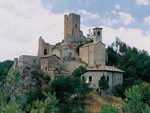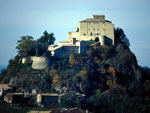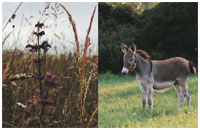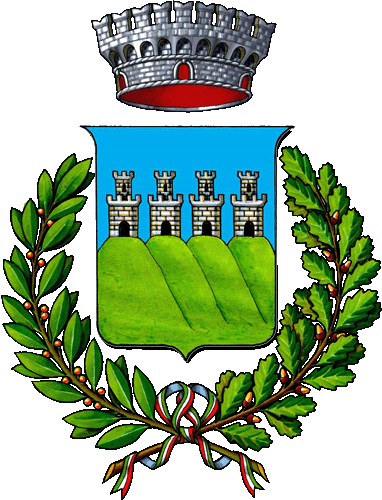Nei dintorni/ In the surroundings
Il castello di Bianello si inserisce in un territorio ricco di arte, natura e tradizione enogastronomica.
Castelli matildici, pievi, oratori e torri si integrano in un paesaggio naturale particolare dove calanchi, boschi e campi coltivati si alternano in colori e forme affascinanti.
Ricordiamo la Pietra di Bismantova, citata dal sommo Dante Alighieri nella Divina Commedia, l’oasi di Bianello, che cinge il castello omonimo in un verde abbraccio, il parco di Roncolo, area
naturalistica e ricreativa.
Poco distante da Quattro Castella troviamo anche altri castelli matildici come Rossena, Canossa, il castello di Carpineti e le pievi di Toano, Caviano, S. Vitale.
Dopo un itinerario nel verde non mancano le possibilità di saziare altri sensi.
I vigneti, i caselli e gli allevamenti di suini e mucche ci ricordano i nostri prodotti più famosi come il Parmigiano Reggiano, il formaggio più conosciuto al mondo grazie alle sue elevate proprietà nutrizionali, il Prosciutto e gli altri salumi dal sapore inconfondibile, il Lambrusco reggiano e l’aceto balsamico tradizionale.
The castle of Bianello is part of a territory rich for artistic, natural and food&wine tradition. Matildic castles, parish churches, oratories and towers are integrated into a particular natural landscape where badlands, woods and cultivated fields alternate in fascinating colors and shapes. For example, the Stone of Bismantova, mentioned by the great Dante Alighieri in the Divine Comedy, the oasis of Bianello, which surrounds the castle of the same name in a green embrace, the park of Roncolo, naturalistic and recreational area. Not far from Quattro Castella we also find other Matildic castles such as Rossena, Canossa, the castle of Carpineti and the parishes of Toano, Caviano, S. Vitale.
After an itinerary in the woods there is no shortage of possibilities to satisfy other senses. The vineyards, the cheese factories and the pig and cow farms remind us of our most famous products such as Parmigiano Reggiano, the most famous cheese in the world thanks to its high nutritional properties, Prosciutto and other cured meats with an unmistakable flavor, Lambrusco wine and traditional balsamic vinegar. The road of wines and flavors crosses our landscape celebrating a millenary culinary tradition that makes Emilia the most interesting “food valley” in Italy.
Chiesa di Sant’Antonino
Posta ai piedi dei quattro colli l’edificio compare nei documenti dopo il 1000 come filiale della Pieve di Bibbiano e fu riedificata nella sua forma attuale tra la fine del secolo XVII e gli inizi del XVIII ad opera della famiglia Canossa sulle fondamenta della precedente struttura medievale.
Dedicata a Sant’Antonino, santo dalla vita controversa, seppur di modeste dimensioni venne abbellita da numerose opere d’arte, tra le quali alcune tele seicentesche e un tabernacolo di D.F.Ceccati. Interessante esempio di scultura romanica, la Chiesa presenta diversi frammenti di rilievi (fine 1000-1100) in pietra arenaria già parte integranti della ricca decorazione romanica originaria ed ora inseriti nei muri esterni della Chiesa.
Church of St. Antoninus
Located at the foot of the four hills, the building appears in documents after 1000 as a branch of the parish church of Bibbiano and was rebuilt in its present form between the end of the 17th and the beginning of the 18th century by the Canossa family, on the foundations of the previous Medieval structure. Dedicated to St. Antoninus, a saint with a controversial life, although modest in size it was enriched with numerous works of art, including some 17th century canvases and a tabernacle by D.F. Ceccati. As an interesting example of Romanesque sculpture, the Church has several fragments of reliefs (late 1000-1100) in sandstone which were part of the rich original Romanesque decoration and are now inserted in the external walls of the Church.
Chiesa della Madonna della Battaglia
Si trova alle spalle del Castello di Bianello, poco oltre Bergonzano. Fu eretta in memoria della vittoria ottenuta dalle truppe armate di Matilde sulle truppe imperiali nel 1092.
Questa battaglia cambiò il corso degli avvenimenti poiché dopo di essa l’imperatore Enrico IV lasciò definitivamente l’Italia. Fu ricostruita in gran parte nel 1724.
Church of the Madonna della Battaglia (Lady of the Combat)
It is located behind the Castle of Bianello, just beyond Bergonzano. It was erected in memory of the victory obtained by Matilda’s armed troops over the imperial army in 1092. This battle changed the course of events since after it Emperor Henry IV left Italy forever. It was largely rebuilt in 1724.
Castello di Carpineti
 Già nel IX secolo il castello di Carpineti viene citato in alcuni documenti ma sarà la Contessa Matilde a valorizzare il complesso. All’interno della fortificazione, provvista di un doppio ordine di mura, la Contessa ordina l’edificazione della chiesetta di stile romanico dedicata a Sant’Andrea, tuttora ben conservata. La fortezza di Carpineti viene eletta quale sede privilegiata per ospitare pontefici, imperatori, re e duchi. Nel 1077 accoglie papa Gregorio VII, reduce dall’incontro di Canossa mentre nel 1082 riceve il vescovo di Lucca Anselmo. La morte di Matilde nel 1115 chiude il periodo più denso di avvenimenti nella storia di questo castello, conteso tra Papato ed Impero. Nei secoli seguenti la fortezza di Carpineti subisce diversi assalti e si susseguono al potere più proprietari, fra i quali anche il leggendario “bandito della montagna” Domenico Amorotto (secolo XVI). A circa quattro chilometri dal castello da segnalare l’antica Pieve di San Vitale, la cui canonica è stata oggetto di recenti restauri e oggi adibita a ostello e ristorante. I ruderi del castello sono di proprietà della Provincia di Reggio Emilia e sono visitabili.
Già nel IX secolo il castello di Carpineti viene citato in alcuni documenti ma sarà la Contessa Matilde a valorizzare il complesso. All’interno della fortificazione, provvista di un doppio ordine di mura, la Contessa ordina l’edificazione della chiesetta di stile romanico dedicata a Sant’Andrea, tuttora ben conservata. La fortezza di Carpineti viene eletta quale sede privilegiata per ospitare pontefici, imperatori, re e duchi. Nel 1077 accoglie papa Gregorio VII, reduce dall’incontro di Canossa mentre nel 1082 riceve il vescovo di Lucca Anselmo. La morte di Matilde nel 1115 chiude il periodo più denso di avvenimenti nella storia di questo castello, conteso tra Papato ed Impero. Nei secoli seguenti la fortezza di Carpineti subisce diversi assalti e si susseguono al potere più proprietari, fra i quali anche il leggendario “bandito della montagna” Domenico Amorotto (secolo XVI). A circa quattro chilometri dal castello da segnalare l’antica Pieve di San Vitale, la cui canonica è stata oggetto di recenti restauri e oggi adibita a ostello e ristorante. I ruderi del castello sono di proprietà della Provincia di Reggio Emilia e sono visitabili.
Castle of Carpineti
The castle of Carpineti was mentioned in some documents already in the 9th century, but it was Countess Matilda who enhanced the complex. Inside the fortification, equipped with a double order of walls, the Countess ordered the construction of the Romanesque-style church dedicated to St. Andrew, which is still well preserved. The fortress of Carpineti was elected as a privileged seat to host popes, emperors, kings and dukes. In 1077 he welcomed Pope Gregory VII, coming from the Canossa meeting, while in 1082 he received Anselmo, bishop of Lucca. The death of Matilda in 1115 ends the most eventful period in the history of this castle, disputed between the Papacy and the Empire. In the following centuries, the fortress of Carpineti underwent several assaults and different owners, including the legendary “bandit of the mountain” Domenico Amorotto (16th century). About four kilometers from the castle, it is worth mentioning the ancient parish church of San Vitale, whose rectory has been the subject of recent restorations and is now used as a hostel and restaurant. The ruins of the castle are owned by the Province of Reggio Emilia and can be visited.
Castello di Rossena e la torre di Rossenella
 Il profilo della fortezza di Rossena, impiantata su un rossastro colle vulcanico, costituisce uno degli scorci paesaggistici più suggestivi di tutta l'area matildica. A differenza di altri castelli che nel tempo si sono trasformati in residenze signorili, Rossena ha conservato l’impianto originario di vera e propria macchina da guerra che doveva fermare eventuali aggressioni nemiche provenienti dalla valle dell’Enza. Il castello, forse iniziato nel 950, all’inizio era costituito da un mastio isolato, la cui struttura (ora ribassata) è ancora leggibile al centro della costruzione principale. Di proprietà della Diocesi reggiana, Rossena ha subito un profondo restauro in occasione del Giubileo dell’anno 2000 che ne ha permesso il recupero per usi ricettivi. Oggi ospita un ostello con una cinquantina di posti letto. E’ interamente visitabile, a pagamento, con accesso alle cisterne e al cammino di ronda dove, nelle giornate limpide, si ammira uno splendido panorama. Di fronte a Rossena si staglia la torre di Rossenella, raggiungibile tramite un facile sentiero e visitabile (da primavera a fine ottobre, la domenica pomeriggio) tutti i giorni dell'anno, su richiesta (telefonando all'Ufficio Informazioni di Canossa 0522 - 872225). I colli vulcanici su cui sorgono il castello e la torre fanno parte della Riserva Naturale Integrata della Rupe di Campotrera, istituita con legge regionale.
Il profilo della fortezza di Rossena, impiantata su un rossastro colle vulcanico, costituisce uno degli scorci paesaggistici più suggestivi di tutta l'area matildica. A differenza di altri castelli che nel tempo si sono trasformati in residenze signorili, Rossena ha conservato l’impianto originario di vera e propria macchina da guerra che doveva fermare eventuali aggressioni nemiche provenienti dalla valle dell’Enza. Il castello, forse iniziato nel 950, all’inizio era costituito da un mastio isolato, la cui struttura (ora ribassata) è ancora leggibile al centro della costruzione principale. Di proprietà della Diocesi reggiana, Rossena ha subito un profondo restauro in occasione del Giubileo dell’anno 2000 che ne ha permesso il recupero per usi ricettivi. Oggi ospita un ostello con una cinquantina di posti letto. E’ interamente visitabile, a pagamento, con accesso alle cisterne e al cammino di ronda dove, nelle giornate limpide, si ammira uno splendido panorama. Di fronte a Rossena si staglia la torre di Rossenella, raggiungibile tramite un facile sentiero e visitabile (da primavera a fine ottobre, la domenica pomeriggio) tutti i giorni dell'anno, su richiesta (telefonando all'Ufficio Informazioni di Canossa 0522 - 872225). I colli vulcanici su cui sorgono il castello e la torre fanno parte della Riserva Naturale Integrata della Rupe di Campotrera, istituita con legge regionale.
Castle of Rossena and the tower of Rossenella
The profile of the fortress of Rossena, built on a reddish volcanic hill, is one of the most evocative landscape views of the whole Matildic area. Unlike other castles that over time have been transformed into stately homes, Rossena has preserved the original structure of a real war machine that was to stop any enemy attacks coming from the Enza valley. The castle, perhaps begun in 950, initially consisted of an isolated keep, whose structure (now lowered) can still be seen in the centre of the main building. Owned by the diocese of Reggio, Rossena underwent a deep restoration on the occasion of the Jubilee of the year 2000, which allowed it to be recovered for hospitality purposes. Today it houses a hostel with about fifty beds. It can be visited entirely, for a fee, with access to the cisterns and the patrol path where, on clear days, you can admire a splendid view. In front of Rossena stands the Rossenella tower, which can be reached via an easy path and can be visited (from spring to the end of October, on Sunday afternoon) every day of the year, on request (by calling the Canossa Information Office 0522-872225). The volcanic hills on which the castle and tower stand are part of the Rupe di Campotrera Integrated Nature Reserve, established by regional law.
La Pietra di Bismantova
Dalle colline di Canossa ha inizio l’Appennino Reggiano che innalza a sud, nella direzione delle Regioni Toscana e Liguria, fino alle sue vette più alte che superano i duemila metri.
Il clima fresco e asciutto, le bellezze naturali, i fiumi ancora puliti, i boschi, i monti hanno fatto di questo territorio una meta turistica ambita e frequentata: in estate, in numerose località sparse ovunque; in inverno, nelle stazioni sciistiche rinomate anche oltre l’Emilia.
Lungo il fiume Enza, ad aprile, nel cuore del territorio matildico, si svolgono importanti gare internazionali di canoa-kajak.
Nel medio Appennino si innalza la fantastica rupe di Bismantova, dall’aspetto di un quadrato tavolato di arenaria, citata dal poeta Dante Alighieri nella Divina Commedia. E’ oggi una meta molto conosciuta per gli appassionati delle arrampicate su roccia.
Ai suoi piedi si trova il centro di Castelnovo né Monti, una cittadina fra le più eleganti e attrezzate di tutto l’Appennino settentrionale.
Più in alto ci si avvicina al crinale, i boschi si fanno vasti e selvaggi, i torrenti si gonfiano di acqua pulita, i monti si increspano fino alle vette rocciose, popolate da cervi e da lupi.
Questo territorio è stato tutelato con la costituzione di un Parco Nazionale che si estende sia nel versante emiliano dell’Appennino che nel lato toscano.
Stone of Bismantova
The Reggio Apennines begin from the hills of Canossa and rise to the south, in the direction of the regions of Tuscany and Liguria, up to its highest peaks that exceed two thousand meters. The cool and dry climate, the natural beauties, the still clean rivers, the woods, the mountains have made this area a popular and appreciated tourist destination: in summer, in several locations scattered everywhere; in winter, in well-known ski resorts even beyond Emilia. Along the Enza river, in April, in the heart of the Matildic area, important international canoe-kajak competitions are held.
In the middle Apennines the fantastic Bismantova cliff rises, looking like a square sandstone plank, mentioned by the poet Dante Alighieri in the Divine Comedy. Today it is a well-known destination for rock climbing enthusiasts. At its foot lies the center of Castelnovo né Monti, one of the most elegant and well-equipped towns in the entire northern Apennines. As you get closer to the ridge, the woods become vast and wild, the streams swell with clean water, the mountains ripple up to the rocky peaks, populated by deer and wolves. The territory was protected with the establishment of a National Park that extends both on the Emilian side of the Apennines and on the Tuscan one.
Oasi di Bianello
 Il Complesso delle Quattro Castella comprende l'Oasi di protezione della fauna del Bianello. Questa è stata istituita nel 1982 dalla Provincia di Reggio Emilia come ambito di protezione della fauna selvatica: un insieme di caratteri morfologici e naturalistici peculiari alla conservazione ai fini delle scienze naturali.
Il Complesso delle Quattro Castella comprende l'Oasi di protezione della fauna del Bianello. Questa è stata istituita nel 1982 dalla Provincia di Reggio Emilia come ambito di protezione della fauna selvatica: un insieme di caratteri morfologici e naturalistici peculiari alla conservazione ai fini delle scienze naturali.
Un biotopo di rilevante interesse naturalistico per la conservazione del territorio. Occupa la zona di transizione tra la pianura e la collina. Sulla morfologia di rocce di origine il paesaggio boscoso, gli anfiteatri calanchivi.
Oasis of Bianello
The complex of the four castles includes the Bianello fauna protection oasis. This was established in 1982 by the Province of Reggio Emilia as an area for the protection of wildlife: a set of morphological and naturalistic characteristics relevant to conservation for the purposes of natural sciences.
A biotope of significant naturalistic interest for the conservation of the territory, it occupies the transition zone between the plain and the hill.
Parco di Roncolo
Il Parco di Roncolo è un'area naturalistica e ricreativa collinare di proprietà della
PRovincia di Reggio Emilia posta a 16 km da Reggio Emilia , poco prima di Quattro Castella.
La sua vicinanza alla città, la natura dolce del rilievo, l'alternarsi di boschi e di ampi prati periodicamente sfalciati, la presenza di attrezzature facilitano la fruizione dell'area, richiamando un vasto pubblico nella bella stagione. Numerose sono le scolaresche che lo visitano.
Aperto al pubblico tutti i giorni dalle ore 8.00 alle 24.00, Roncolo è la meta ideale per lo svago, le attività all'aria aperta e lo sport. Esso è anche meta privilegiata per tutti coloro vogliano svolgere attività di gruppo all'aria aperta, sia sportive che ricreative: da alcuni anni vi si svolgono infatti regolarmente, a cura di associazioni locali, gare di orienteering e manifestazioni con balli etnici e danze popolari.
I 44 ettari del parco sono in parte ricoperti da un bosco misto in cui prevalgono il carpino nero e la roverella, insieme a orniello, nocciolo, ciliegio selvatico, pioppo nero e pino silvestre, fornendo una significativa varietà di paesaggi.
Numerosi sentieri recentemente incrementati attraversano il parco e sono utilizzati per passeggiate e trekking. Lungo i sentieri si snoda un percorso ginnico attrezzato. Il parco dispone di aree attrezzate con tavoli e panche.
Un bar con piacevole distesa esterna, consente un agevole ristoro da aprile a settembre compresi, che in estate si prolunga anche in orario serale; nei mesi di giugno, luglio ed agosto il bar è infatti aperto dalle ore 11 alle 24, dal martedì alla domenica.
La fruizione del parco è disciplinata da un apposito Regolamento che disciplina gli accessi e fornisce le principali norme comportamentali cui gli utenti devono attenersi.
Per l'organizzazione di attività di gruppo organizzate è necessario richiedere autorizzazione al dirigente responsabile mediante apposito modulo scaricabile dal sito internet della Provincia, nella sezione Territorio e Natura.
Park of Roncolo
The Park of Roncolo is a hilly naturalistic and recreational area owned by the Province of Reggio Emilia and located 16 km from Reggio Emilia, just before Quattro Castella. Its proximity to the city, the gentle nature of the hills, the alternation of woods and large meadows periodically mown, the presence of equipment facilitate the use of the area, attracting a large public in the summer. Numerous school groups visit it.
Open to the public every day from 8.00 to 24.00, Roncolo is the ideal destination for leisure, outdoor activities and sport. It is also a privileged destination for all those who want to carry out group activities in the open air, both sporting and recreational: for some years, indeed, orienteering competitions and events with ethnic and folk dances have been held here regularly, organized by local associations.
The 44 hectares of the park are partly covered by a mixed forest in which black hornbeam and downy oak prevail, together with ash, hazelnut, wild cherry, black poplar and Scots pine, providing a significant variety of landscapes. Several recently increased paths cross the park and are used for walking and trekking. A well-equipped gymnastic path winds along the road. The park has areas equipped with tables and benches.
A bar with a pleasant outdoor area allows easy refreshment from April to September inclusive, which in summer also extends into the evening; in fact, in the months of June, July and August the bar is open from 11 to 24, from Tuesday to Sunday.
The use of the park is ruled by a specific regulation that governs access and provides the main behavioral rules that users must comply with. For the organization of organized group activities, it is necessary to request authorization from the manager in charge using a specific form that can be downloaded from the Province website, in the Territory and Nature section.
Pieve di Toano
La Pieve di Toano si erige sul monte più alto di Toano e le prime notizie della sua esistenza si hanno poco dopo il Mille, ai tempi di Bonifacio di Canossa, padre di Matilde.
Delle robuste mura difensive e del castello non vi è più traccia a parte nel campanile dove rimane ancora la base di un torrione.
Esteriormente colpisce la semplicità delle linee architettoniche, che conferiscono al monumento particolare solennità, di una bellezza tipicamente romanico-lombarda.
L'interno è caratterizzato da una nuda spazialità che sembra immergerci in un'atmosfera di tempi lontani. I capitelli di notevole pregio storico-artistico richiamano elementi di altre pievi coeve e hanno motivi bizantino-ravennati, intrecci canusini, figure primitive a tutto rilievo e motivi con foglie stilizzate di acanto e tralci d'uva.
Parish church of Toano
The parish church of Toano stands on the highest mountain of Toano and the first statement of its existence comes shortly after the year 1000, at the time of Bonifacio di Canossa, Matilda’s father. There is no trace of the strong defensive walls and of the castle, apart from the bell tower, where the grounding structure of a tower still remains.
Outwardly, the simplicity of the architectural lines is striking, giving the monument a particular solemnity, of a typically Lombard-Romanesque beauty. The interior is characterized by a bare spatiality that seems to immerse us in an atmosphere of faraway times. The capitals of considerable historical and artistic value recall elements of other contemporary parish churches and have Byzantine-Ravenna motifs, Canusian interlacing, primitive figures in full relief and motifs with stylized acanthus leaves and grape shoots.
Pieve di Caviano
La pieve di Caviliano (o, più modernamente, Caviano) figura in una carta del 1070 ceduta da parte della Chiesa di Reggio al Marchese Bonifacio, padre di Matilde di Canossa.
Edificata a margine di un’antica via che costeggiava la Valle dell’Enza, in uso probabilmente anche in epoca romana, è uno degli edificio più antichi rimasti dell’età medioevale nel territorio matildico.
La chiesa è divisa in tre navate, delimitate da colonne che risalgono al secolo XII. Il pavimento attuale è sopraelevato rispetto a quello originale e testimonia i diversi interventi di ristrutturazione avvenuti nel corso dei secoli.
Recenti lavori di restauro hanno riportato alla luce l’antica cripta della chiesa con splendidi affreschi risalenti ad epoche diverse e la pregevole fonte battesimale ad immersione, in pietra scolpita, ora conservata nei Musei Civici di Reggio Emilia.
Parish church of Caviano
The parish church of Caviliano (or, more modernly, Caviano) appears in a 1070 charter given by the Church of Reggio to the Marquis Bonifacio, Matilda’s father. Built on the edge of an ancient road that ran along the Enza Valley, probably also in use in Roman times, it is one of the oldest remaining buildings from the Middle Ages in the Matildic territory.
The church is divided into three naves, delimited by columns that date back to the 12th century. The current floor is raised compared to the original one and testifies to the various renovations that have taken place over the centuries. Recent restoration work has brought to light the ancient crypt of the church with splendid frescoes dating back to different eras and the valuable immersion baptismal font, in carved stone, now preserved in the Civic Museums of Reggio Emilia.
Castello di Canossa
Il castello, eretto su una rupe di arenaria bianca, fu edificato nel 940 da Atto Adalberto, di stirpe longobarda.
La posizione strategica di questo castello ha costituito un caposaldo naturale fin dai tempi più remoti. Verso la metà del X secolo Azzo Adalberto rese più munito e resistente il castello e vi edificò il Tempio di S. Apollonio.
Il complesso divenne fulcro della potenza della famiglia dei Canossa e, nel 1077, qui fu concesso lo storico "perdono" del Papa Gregorio VII all'imperatore Enrico IV cugino di Matilde di Canossa.
Nel 1115 con la morte di Matilde per il castello inizia un periodo di declino, segnato da distruzioni e attacchi.
Solo nel 1878 lo Stato Italiano acquistò i ruderi del castello dichiarando Canossa monumento nazionale. Della struttura originaria rimangono tracce delle mura e della cripta del tempio. All'interno del castello si trova un piccolo Museo Nazionale che conserva, fra l'altro, un prezioso fonte battesimale del XII secolo.
Castle of Canossa
The castle, built on a white sandstone cliff, was erected in 940 by Adalberto Atto, of Lombard lineage. The strategic position of this castle has been a natural cornerstone since the earliest times. Towards the middle of the 10th century Adalberto made the castle more equipped and resistant and built the Temple of St. Apollonius there.
The complex became the fulcrum of the power of the Canossa family and, in 1077, Pope Gregory VII granted here the historic “pardon” to Emperor Henry IV, cousin of Matilda of Tuscany. In 1115, after the death of Matilda, the castle underwent a period of decline, marked by destruction and attacks.
Only in 1878 did the Italian State purchase the ruins of the castle, declaring Canossa a national monument. Of the original structure remain only traces of the walls and the temple crypt. Inside the castle there is a small National Museum which houses, among other things, a precious baptismal font from the 12th century.
Chiesa Santa Maria della Mucciatella (Puianello)
In posizione panoramica, rifabbricata come gran parte delle altre chiese del '700, presenta un'elegante facciata con fronte centrale a capanna. La chiesa è considerata un sito templare.
Church of St. Mary (Santa Maria della Mucciatella, Puianello)
In a panoramic position, rebuilt like most of the other 18th century churches, it has an elegant façade with a central gabled front. The church is considered a Templar site.


